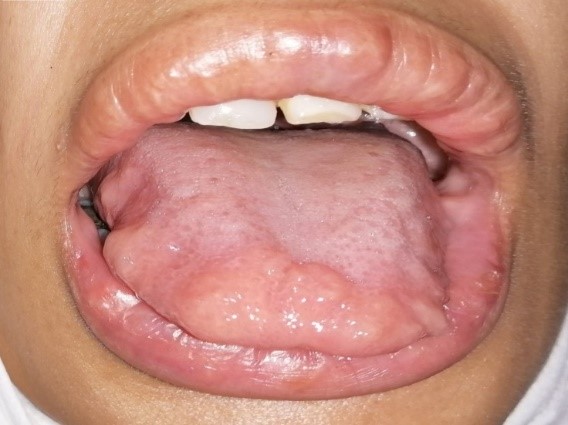Multiple hypertrophied tongue lesions in a young hypertensive woman Multiple endocrine neoplasia type 2B (MEN 2B) syndrome
School of Medicine Students' Journal,
Vol. 3 No. 4 (2021),
31 December 2021
https://doi.org/10.22037/smsj.v3i4.36432
Abstract
A 16-year- old girl with history of hypertension was referred to the surgery department due to multiple hypertrophied lesions in both lips and on the lateral sides of the tongue. The lesions have been appeared gradually within the last year and only issued as a cosmetic concern.
Which one could not be considered as the differential diagnosis of the patient?
- neurofibroma
- neurilemoma
- Leukoplakia
- Neuroma
Correct answer:
- This figure demonstrates enlarged lip and hypertrophied tongue lesions which can be seen in neurofibroma, traumatic neuroma, neurilemoma, granular cell tumor, and neuroma; the net diagnosis is made by microscopic examination of a tissue biopsy. Leucoplakia as it is understood by its name is a white plaque with wide range of differential diagnosis; trauma, lichen planus, systemic lupus erythematous (SLE), leukoedema, and malignancy.
On retrograde history taking, the patient had a total thyroidectomy due to medullary thyroid carcinoma (MTC) two years ago and right adrenalectomy due to pheochromocytoma last year.
What would be the most probable diagnosis?
- Neurofibromatosis type 1
- MEN 2A syndrome
- MEN 2B syndrome
- MEN 1 syndrome
Correct answer:
- The classic combination of the mucosal neuroma, MTC, and pheochromocytoma together define the multiple endocrine neoplasia type 2B (MEN 2B). Patients with MEN 2B syndrome also might have marfanoid features. In Neurofibromatosis type 1, neurofibromas, multiple café- au- lait spots, iris hamartomas, skeletal abnormalities, glioma, and cognitive disorders are expected. MEN 2A is identical with MEN 2B but instead of marfanoid features and neuromas, parathyroid hyperplasia is seen. MEN 1 syndrome is characterized by pituitary adenoma, parathyroid hyperplasia, and pancreatic tumor.
Due to the high fatality of MTC, early detection of MEN 2B cases and prophylactic thyroidectomy is of great importance and clinical suspicion to MEN 2B by non- endocrinologic features is critical in patients [1]. Currently, growing evidence is affecting our mindset about the clinical picture of MEN 2B syndrome. While MEN 2B patients are classically considered to be tall with marfanoid features, current studies report pediatric patients with proportionate short stature. It is also highlightable that intestinal ganglioneuromatosis associated with MEN 2B, should be considered in the differential diagnosis of Hirschsprung’s disease in children with constipation during early infancy.
- Multiple endocrine neoplasia
- MEN 2B
- Neuroma
- Pheochromocytoma
- Paraganglioma
- Tongue lesion
- Marfanoid features
- Medullary thyroid carcinoma
- MTC
- Proportionate short stature
- intestinal ganglioneuromatosis

How to Cite
References
van den Broek MFM, van Santen HM, Valk GD, Verrijn Stuart AA. Children with multiple endocrine neoplasia type 2B: Not tall and marfanoid, but short with normal body proportions. Clinical endocrinology. 2021;95(3):453-9.
van den Broek MFM, Rijks EBG, Nikkels PGJ, Wolters VM, van Es RJJ, van Santen HM, et al. Timely diagnosis of multiple endocrine neoplasia 2B by identification of intestinal ganglioneuromatosis: a case series. Endocrine. 2021;72(3):905-14.
Zhang L, Guo Y, Ye L, Lu W, Dong Z, Wang W, et al. Severe constipation as the first clinical manifestation in multiple endocrine neoplasia type 2B: a case report and literature review. BMC pediatrics. 2020;20(1):318.
- Abstract Viewed: 179 times




